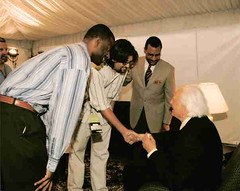Del Rio's Big Apples
- Ed. note: I was recently asked to critique four youth ministry resources for a national organization. Here are my thoughts in order of preference.
One critique applies generally to all four: none of them relate their respective teachings to urban youth ministry. The stories that are told come largely out of a suburban cultural context, and there isn’t a discernable attempt to assess whether the principles are transferable outside of that context. They also seem to assume a paradigm of paid, full-time youth workers, while bivocational volunteers comprise the youth ministry ranks in most inner cities, and, for that matter, mainline congregations. In an era of repopulation back into urban centers and disproportionate cultural influence by cities, youth ministry needs to be reimagined.
1. Helping Teenagers in Crisis is a refreshing, if challenging, change of pace for youth ministers tired of cliché answers to complicated, real-life issues. Teenagers confront an inherently tumultuous world filled with hormonal changes, identity questions, and family and relationship drama, even before the jarring impact of crisis. Writing out of their own extensive experience, Van Pelt and Hancock offer a useable framework for how to approach ministry circumstances that take readers beyond more limited experiences. They ground the theoretical and prescriptive with compelling anecdotes that explore the good, bad, and ugly of crisis intervention, while offering hope that even if we get it wrong sometimes, that’s usually beside the point. 4 Big Apples
2. Do They Run When They See You Coming? asks the question begging for scrutiny behind the walls of many of our evangelical enclaves: Why is so much of what Christians do irrelevant to the people Jesus commissioned us to lovingly reach? Even better, it does so in a non-threatening way. If HTIC ratchets up the intensity by digging deep around a focused subject, DTR is more like Sports Center – a collection of highlights that give a feel for the action without all the gripping drama of the play-by-play. It offers enough sound-bites to tell the story without all the overtime nail-biting. On the whole, it’s an excellent resource to provoke youth ministers to rethink how and why Christ still calls us to be fishers of men. 3 Big Apples
3. Am I good Enough? makes the subject of Luther’s “grace-not-works” epiphany and Paul’s “righteousness as filthy rags” lament approachable for teens. While there’s nothing particularly new here (even borrowing from C.S. Lewis’ timeless “Liar, Lunatic, Lord” apologetic) it provides a readable context for young people to understand Christ as Savior, the cross as redemptive, and the resurrection as real, relevant, and personal. 2 Big Apples
 4. While the producers of the The Gospel Journey should be applauded for attempting a multimedia training tool for teens to reach their peers, this product is flawed. On the whole, the teaching is fine as a primer on the gospel, and Greg Stier again demonstrates his skill as a communicator. But the mountaintop setting feels contrived; the attempted “reality show” dynamics feel less real than primetime alternatives; and the characters come across as stereotypes. The text-only tracts are even more disappointing as small font size, no white space, and generic graphics are unlikely to lure teen readers. Great concept; good teaching; unsatisfying results. 1 Big Apple
4. While the producers of the The Gospel Journey should be applauded for attempting a multimedia training tool for teens to reach their peers, this product is flawed. On the whole, the teaching is fine as a primer on the gospel, and Greg Stier again demonstrates his skill as a communicator. But the mountaintop setting feels contrived; the attempted “reality show” dynamics feel less real than primetime alternatives; and the characters come across as stereotypes. The text-only tracts are even more disappointing as small font size, no white space, and generic graphics are unlikely to lure teen readers. Great concept; good teaching; unsatisfying results. 1 Big Apple













0 Comments:
Post a Comment
<< Home